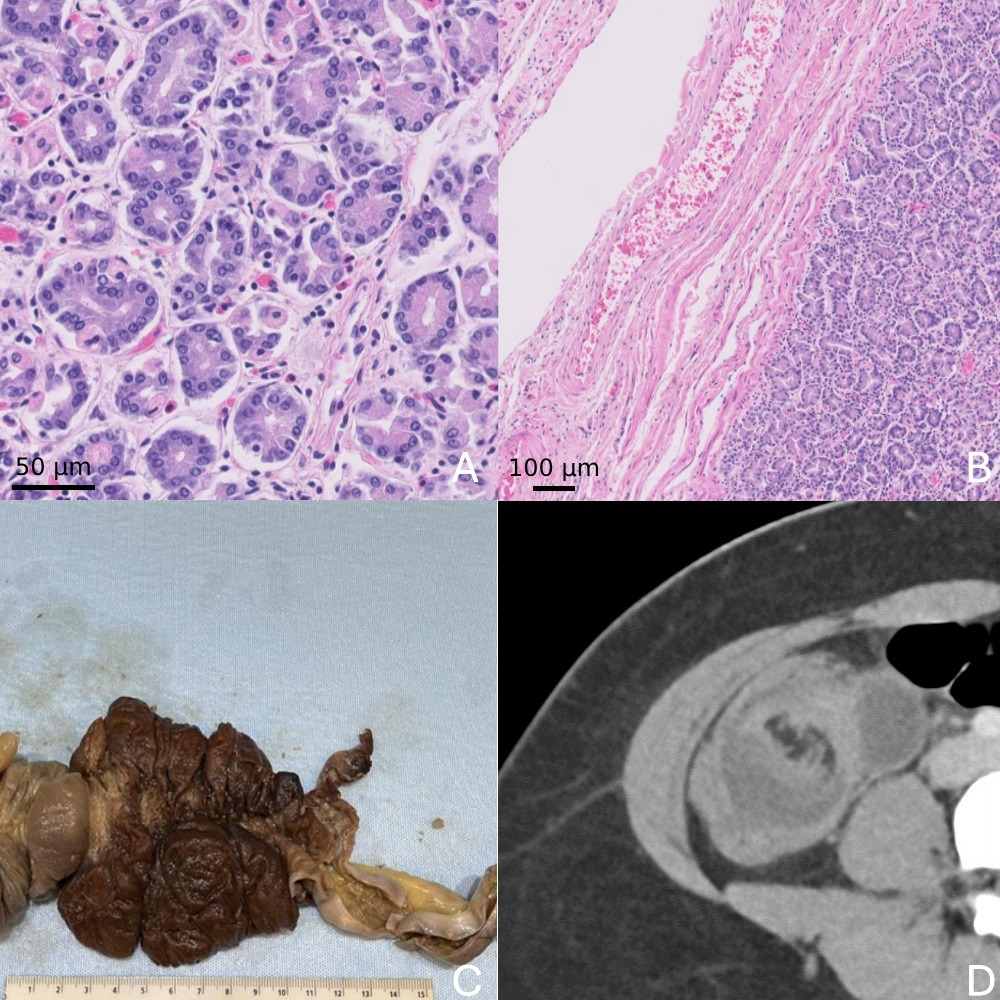Tuesday Poster Session
Category: Small Intestine
P5005 - Gastric Heterotopia Causing Intussusception in a Young Adult
Tuesday, October 29, 2024
10:30 AM - 4:00 PM ET
Location: Exhibit Hall E

Has Audio

Yizhong Wu, MD
Baylor Scott & White Medical Center
Georgetown, TX
Presenting Author(s)
Yizhong Wu, MD1, Manuel Garza, MD, MS2, Emma Russell, BS3, Roy Burch, MS4, Mary Wong, MD4
1Baylor Scott & White Medical Center, Georgetown, TX; 2Baylor Scott & White Medical Center, Austin, TX; 3Texas A&M School of Medicine, Austin, TX; 4Baylor Scott & White Medical Center, Temple, TX
Introduction: This case report presents intussusception in a young adult caused by heterotopic gastric tissue. The classic triad of abdominal pain, vomiting, and pathognomonic jelly currant stools is seen in pediatric patients. Adult presentation is characterized by intermittent and non-specific abdominal pain. While there are several previously reported pediatric cases, gastric heterotopia (GH) is a rare cause of adult intussusception.
Case Description/Methods: A 19-year-old female presented with sudden onset right lower quadrant abdominal pain associated with nausea and vomiting for one day. She denied any prior or chronic gastrointestinal symptoms including bloody bowel movements, recurrent abdominal pain, or bloating. The patient had no past medical history or history of abdominal surgeries. Physical exam was pertinent for an afebrile adult with non-distended abdomen and right lower quadrant tenderness. Labs were notable for anemia with hemoglobin of 10.1 g/dL. Computed tomography of the abdomen and pelvis revealed ileocolic intussusception with associated bowel wall inflammation. She underwent open right hemicolectomy of the intussuscepted bowel and ileocolic anastomosis was created. Subsequent histopathologic exam showed a segment of GH.
Discussion: Intussusception is rarely diagnosed in adults, accounting for less than 5% of bowel obstruction etiology.1 While most pediatric cases are idiopathic, around 90% of adult cases have a pathologic, often neoplastic, lead point.2 Few cases of adult intussusception secondary to heterotopic gastric tissue have been described, and only one reported an ileal lead-point.2 GH most commonly stems from vitelline duct remnants; however, it has been reported throughout the alimentary tract and in rare cases can be independent of a Meckel’s diverticulum.3 This case stands out as one of these very rare cases of GH not associated with a Meckel’s.
References:

Disclosures:
Yizhong Wu, MD1, Manuel Garza, MD, MS2, Emma Russell, BS3, Roy Burch, MS4, Mary Wong, MD4. P5005 - Gastric Heterotopia Causing Intussusception in a Young Adult, ACG 2024 Annual Scientific Meeting Abstracts. Philadelphia, PA: American College of Gastroenterology.
1Baylor Scott & White Medical Center, Georgetown, TX; 2Baylor Scott & White Medical Center, Austin, TX; 3Texas A&M School of Medicine, Austin, TX; 4Baylor Scott & White Medical Center, Temple, TX
Introduction: This case report presents intussusception in a young adult caused by heterotopic gastric tissue. The classic triad of abdominal pain, vomiting, and pathognomonic jelly currant stools is seen in pediatric patients. Adult presentation is characterized by intermittent and non-specific abdominal pain. While there are several previously reported pediatric cases, gastric heterotopia (GH) is a rare cause of adult intussusception.
Case Description/Methods: A 19-year-old female presented with sudden onset right lower quadrant abdominal pain associated with nausea and vomiting for one day. She denied any prior or chronic gastrointestinal symptoms including bloody bowel movements, recurrent abdominal pain, or bloating. The patient had no past medical history or history of abdominal surgeries. Physical exam was pertinent for an afebrile adult with non-distended abdomen and right lower quadrant tenderness. Labs were notable for anemia with hemoglobin of 10.1 g/dL. Computed tomography of the abdomen and pelvis revealed ileocolic intussusception with associated bowel wall inflammation. She underwent open right hemicolectomy of the intussuscepted bowel and ileocolic anastomosis was created. Subsequent histopathologic exam showed a segment of GH.
Discussion: Intussusception is rarely diagnosed in adults, accounting for less than 5% of bowel obstruction etiology.1 While most pediatric cases are idiopathic, around 90% of adult cases have a pathologic, often neoplastic, lead point.2 Few cases of adult intussusception secondary to heterotopic gastric tissue have been described, and only one reported an ileal lead-point.2 GH most commonly stems from vitelline duct remnants; however, it has been reported throughout the alimentary tract and in rare cases can be independent of a Meckel’s diverticulum.3 This case stands out as one of these very rare cases of GH not associated with a Meckel’s.
References:
- Begos DG et al. The diagnosis and management of adult intussusception. American journal of surgery, 1997, 173(2), 88–94
- Murshed KA et al. Heterotopic Gastric Mucosa in the Ileum: A Rare Cause for Intussusception in Adults. Case Rep Gastroenterol 2021, 14 (3): 609–614
- Anand, P., Singh, S., & Sarin, N. (2017). Intussusception caused by heterotopic gastric mucosa in small intestine: a case report. Journal of medical case reports, 11(1), 258. https://doi.org/10.1186/s13256-017-1425-x

Figure: Figure 1. A, B: Photomicrographs of the resected heterotopic gastric tissue in terminal ileum. C: Gross specimen of the resected tissue. D: Computed Tomography image of the ileocolic intussusception.
Disclosures:
Yizhong Wu indicated no relevant financial relationships.
Manuel Garza indicated no relevant financial relationships.
Emma Russell indicated no relevant financial relationships.
Roy Burch indicated no relevant financial relationships.
Mary Wong indicated no relevant financial relationships.
Yizhong Wu, MD1, Manuel Garza, MD, MS2, Emma Russell, BS3, Roy Burch, MS4, Mary Wong, MD4. P5005 - Gastric Heterotopia Causing Intussusception in a Young Adult, ACG 2024 Annual Scientific Meeting Abstracts. Philadelphia, PA: American College of Gastroenterology.
